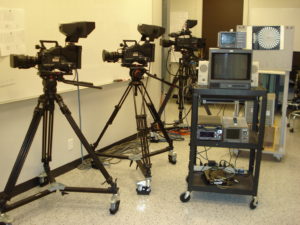Western Association of Broadcasters (WABE) President Rob Brown says the Southern Alberta Institute of Technology (SAIT) has confirmed it’s leaving the future training of broadcast engineers for radio and television to the industry, beyond the current session.
SAIT announced last March that its Broadcast Systems Technology (BXST) program – the last broadcast engineering course of its kind in the country – would fall under provincial budget cuts following the graduation of the current second year cohort.
Established in 1969, the program was one of the few certified by the Society of Broadcast Engineers (SBE) and had just established a new state-of-the-art lab.
While WABE had hoped the program’s cancellation might be reviewed, Brown said it’s clear future training will have to be spearheaded by the industry.
“We now know that the future is going to be considerably different…whatever that is,” Brown told Broadcast Dialogue last week as broadcasters, the film industry, manufacturing, and other employers who hired SAIT grads grapple with training and recruitment questions.
 “This doesn’t just affect broadcast. You have other industries that look for this same skill set – in the motion picture industry where there are a shortage of people who have those trouble shooting skills for television…and all of these cel phone towers and networks coming in. Who is going to put all of these sites together? It’s not just broadcast, it’s media in general,” said Brown.
“This doesn’t just affect broadcast. You have other industries that look for this same skill set – in the motion picture industry where there are a shortage of people who have those trouble shooting skills for television…and all of these cel phone towers and networks coming in. Who is going to put all of these sites together? It’s not just broadcast, it’s media in general,” said Brown.
WABE has been leading discussions with SAIT on steps forward, which Brown said could include the addition of a third year, broadcast-specific course addition to the college’s Electrical Engineering Technology program, a Radio-frequency (RF) engineering add-on to NAIT’s Wireless Systems Engineering Technology course, or other ways to upscale related programming.
“They’ve kind of turned it back to the industry to come up with a solution. They’re trying to find a way to also work and make use of that equipment…they’re really coming back to us as an industry and asking what we can do? Whether that’s micro-programs or if you have people you want to send from your company for training,” said Brown.
WABE is now in the process of consulting with stakeholders, including manufacturers and broadcasters – like Rogers and Corus Entertainment – to assess what the industry needs.
Brown, who is also the Technical Manager at Jim Pattison Broadcast Group in Winnipeg, said Pattison currently has a position posted for a Broadcast Technician Trainee which company Technical Services Director Bill Stovold sees as a potential path forward for their station group.
“That’s where we see it. That way we can train somebody up and take them into a market,” said Brown.
WABE plans to hold another follow-up meeting with stakeholders next month.
Subscribe Now – Free!
Broadcast Dialogue has been required reading in the Canadian broadcast media for 25 years. When you subscribe, you join a community of connected professionals from media and broadcast related sectors from across the country.
The Weekly Briefing from Broadcast Dialogue is delivered exclusively to subscribers by email every Thursday. It’s your link to critical industry news, timely people moves, and excellent career advancement opportunities.
Let’s get started right now.




